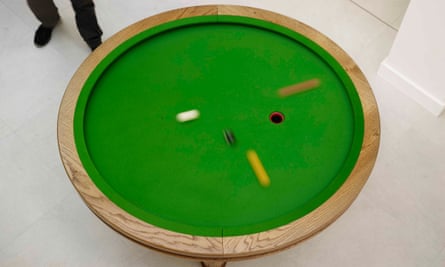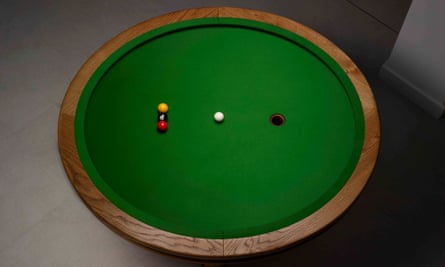When I began writing about maths I had no idea that it would lead me to the glamorous world of indoor sports.
But while I was researching my most recent book I became entranced by the ellipse, the curve that you see whenever you look at a circle side-on.

The ellipse has two significant points, called focuses, which have a remarkable geometrical property that is almost always explained using the example of an imaginary pool table.
If a pool table is the shape of an ellipse, then a ball shot from one focus will always rebound to the other focus no matter in which direction the ball is shot.
That sounded interesting! Wouldn’t it be fun, I thought, if I could build one of these imaginary tables?
So I did.
(Okay, it was actually built to a very high spec by Britain’s top makers of bespoke snooker and pool tables.)
I’ve called the table LOOP and it has a black dot at one focus, and its only pocket at the other.

If you place a ball on the black dot, it will always rebound into the pocket in whichever direction you shoot.
What’s more, if the ball is not on the black dot, it will always rebound into the pocket if rolls over the black dot.
Sounds like LOOP must be incredibly easy, if all you need to do to pocket a ball is to shoot it at the black dot?
Wrong! In an idealised mathematical world with no friction, no napped baize, and where balls do not change the shape of the cushion depending on how fast they are travelling, it may well be an easy game.
Yet in the real world, LOOP becomes a thrilling game of skill because in order to get the desired rebound angle you need to carefully judge the force you hit the ball.
It’s amazingly fun, I promise you. Everyone who has played it so far has loved it.
I’ll be launching LOOP at the Port Eliot Festival on July 31. The table will be situated in a geometrically appropriate arena: the Round Room. Over the course of the weekend festivalgoers will be invited to enter the inaugural LOOP World Championships.
The rules of LOOP are as follows: to start the balls are arranged with the black on the dot, and a yellow and red ball on either side of it, as pictured below. The cue ball is placed on the major axis, and the person who breaks must name the colour he wants to pot. The game then proceeds like pool, with the object to pot your colour and then the black.

I built the table for the purposes of science popularisation, but I’m convinced LOOP could one day be as successful as pool. For a start, the table is a more convenient size for games rooms, bars and offices. The games are fast and addictive. Read my ellipse: LOOP is the future of cue sports.
For more on the mathematics behind LOOP, background to its construction, latest news and how to book a demonstration go to www.loop-the-game.com.
And to keep in touch with me I’m on Twitter, Facebook, Google+ and YouTube.

Comments (…)
Sign in or create your Guardian account to join the discussion